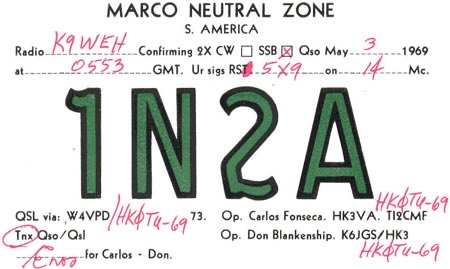

1N2A 1969 Colombia
Marco Neutral Zone
It's was a surprise to find this QSL card on your web site. Somewhere around my house I still have a few blank cards like it from the May 1969 expedition. Here is the history of that interesting DXpedition.
DXPEDITION TO MARCO NEUTRAL ZONE
This account is written by Don Blankenship W4PUL, who in 1969 was K6JGS/HK3 operating from Bogota, Colombia. The other DXpedition operator on 1N2A was Carlos Fonseca TI2CF, then HK3VA in Colombia and TI2CMF in Costa Rica. Carlos was the Civil Attaché at the Costa Rican Embassy in Bogota and I was then assigned to the U.S. embassy in the same capital city. Both Carlos and I were on the February 1969 DXpedition to Malpelo Island (HK0TU) and we both had a burning desire to follow Malpelo with another DXpedition to a new country. We later would operate on San Andres Island as K6JGS/HK0 and TI9CF on Cocos Island.
Marco Neutral Zone was a narrow strip of land between Leticia, Colombia, and Tabatinga, Brazil. Since the 1930's until 1969 this parcel of land had been called Marco and "Tierra de Nadie" or "No Man's Land". It got the name due to an error in a survey done during the 1930's following an armed boundary dispute in this region. Following a settlement of hostilities, a new land survey was commenced. Upon completion, it was discovered that the two independent surveys still could not correct the previous boundary error. Therefore the error was just left alone and 6-foot obelisk-type cement survey markers were erected that simply identified the area as Marco Neutral Zone. Life went on as usual and no one thought more of it until 1969 when I discovered from the U.S Consular Agent in Leticia the unique existence of this neutral zone. What we didn't know then or fully understand was that this border area was still a very sensitive issue, especially for Brazil.
Marco Neutral zone is today defined as a 0.7 mile strip of land with thick jungle trees growing between Brazil and Colombia. It lies between the town of Leticia, Colombia and Tabatinga, Brazil. (See the Google satellite image below). Colombia is to the north (up). The southern end of the town of Leticia is at the top of the image.. The bottom part of the image is Tabatinga, Brazil where you see an airstrip. Brazil appears today to have placed its Tabatinga army garrison right in the middle of this neutral zone where military style bungalows can be seen in the imagery. Forty years ago there was only an Indian village. The Brazilian army garrison was further south at Tabatinga, but no air strip. Back then Leticia had a short dirt airstrip, just large enough for a C-47 to land. I don't even recall an airport control facility, but there probably was one. Today there is a full sized 1.25 mile long commercial jet airstrip just a bit north of Leticia.
I would imagine there was a population of perhaps as much as 500 to 1,000 people living in Leticia when I was first there in 1968. Today it looks like a large town or even a very small city. But in 1968 there was nothing but clay roads with deep gullies and ruts, and there were no paved roads at all.
I believe there was only one small hotel in Leticia in 1969. Mike Tsalikas, the honorary U.S. consul for the huge region of Colombia called Amazonas, owned it. I think there were about six rooms and it was newly constructed. Mike seemed to have his hand in many different things in Leticia, including a small zoo. This was where I had the rare opportunity to allow a massive 300 lb. anaconda rest on my shoulder while his helpers supported most of the weight. He always seem to have a few monkeys on chains nearby him. He was an absolutely fascinating guy with lots of stories about the Amazon to tell anyone who cared to listen. The Amazonian Indians in the region loved and admired him. He seemed to almost have a visual aura surrounding him. There always were people, young and old, many Indians, who surrounded him where ever he went in the village of Leticia. He was a Greek who'd been in the Korean War as a marine and afterwards migrated down through Central America as an adventurer. When he got to Leticia, he met and married a Colombian woman. He was a real swarthy character truly befitting the image of a U.S. Marine. Or better yet, in a modern era, he would have been perfectly cast as Indiana Jones. He was probably in his late 40's at the time we knew him. He raised monkeys and owned an island or large sand bar in the middle of the Amazon river were he bred and sold them to labs in the U.S. He also bred and sold other wild animals, parrots, huge anacondas, caymans, etc.
If you put these coordinates into Google Earth where you normally would type in a place name, you will go to the exact same spot as the 1N2A DXpedition operation, or somewhere very close. In May 1969 this was a remote area right in the jungle. Just copy and paste this coordinate exactly as you see it and place it into the Google Earth search engine.
4 14 41.53 S, 69 55 57.03 W
As you can see the degrees, minutes and seconds are separated with a space. Separate the latitude from longitude with a comma.
The location of Marco Neutral Zone is seen at the bottom of the map indicated by the yellow push pin.
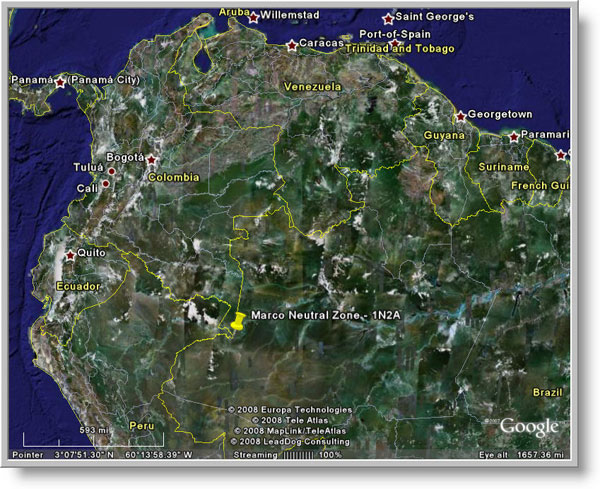
When we were there in May 1969, some 40 years ago, Leticia was only a small town or better described as an Amazon River village that was serviced by Colombian Air Force DC-3 flights every two weeks. These flights brought in fresh vegetables and garlic for the Colombian marine battalion stationed there. Passengers boarded at the Colombia Air Force terminal in Bogota. Paddle wheel river boats made regular trips up and down the river from Manaus, Brazil to Leticia and other ports along the Amazon River. Tabatinga, Brazil was a Brazilian hamlet and also an Army garrison on the other side of the Colombian / Brazilian border. Marco Neutral Zone is where, on Saturday, May 3, 1969, the Brazilian army captured me. They took me to their army stockade and interrogated me, sometimes at gun point, for about 10 hours. More on this story to come.
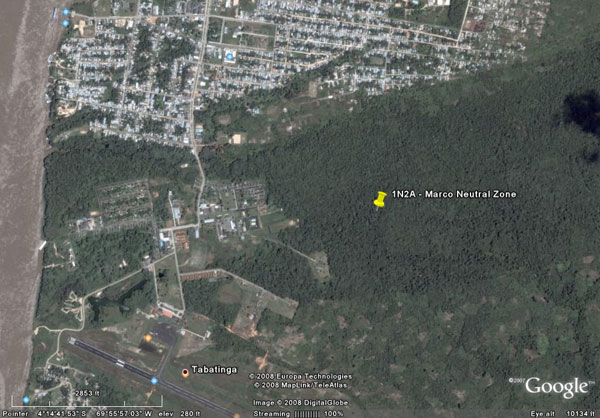
Below you see the primary operator of this DXpedition, Carlos Fonseca TI2CF, HK3VA, TI9CF, HK0TU and also a 2nd op for K6JGS/HK0 San Andres Island. Carlos is an electrical engineer who graduated from Catholic University in Washington DC. I was arrested by the Brazilian military the same day this photo was taken. When I look at this photo and see the prime white shirt Carlos was wearing, it reminds me of just how formal Colombia dress was in the 1960's. A three piece suit was almost mandatory dress wear throughout the country.
The radio equipment consisted of a Swan 500 and a Heathkit SB-101.
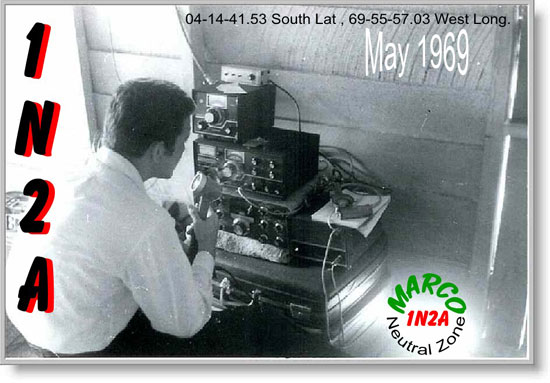
Here's another look at the equipment. HF propagation was really quite good, especially into Europe and the Middle East.

Mike hooked us up with a wretchedly poor family living in the jungle in Marco Neutral Zone. This family allowed us to use a little dilapidated shack which they called home. It was a place like you'd store your old lawn mower, but a family actually lived there. We also got a generator from Mike and paid a few pennies to an Indian trekking crew to march through the jungle with us in this no man's land called "Marco, Tierra de Nadie."
The radio shack was a very small thatched roof dwelling. There was no furniture in the shack. The Brazilian family of five who lived there, slept on the wooden plank flooring. There were no tables in this home and therefore Don and Carlos simply placed the radios on the suitcases that had been used to carry the equipment in. The shack was in a cleared area in the jungle. All around the area were very tall trees and jungle canopy. However, we didn't bring nighttime lighting so our only illumination was the receiver dial lights. The shack was essentially open on all sides. Where you see the logo Marco 1N2A above where Carlos is operating the station, there was a large open area where any kind of critter or insects could easily enter, and did. There were no doors to this home. The temperature was about 95 degrees and the humidity was about 85%. The discomfort index was therefore very high.
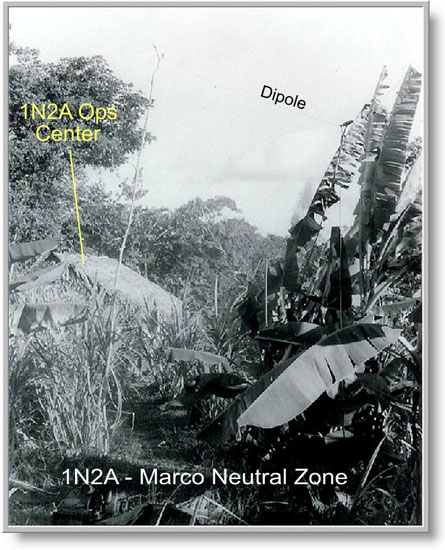
Below is another view of the home that was used as the radio shack. It had a thatched roof and a piece of cloth served as a window shade. There is jungle completely surrounding the home.
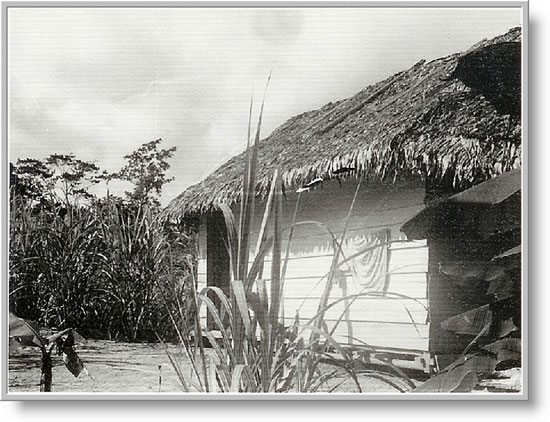
Below we see a photo of the home and perhaps family members or visitors coming to the home to inquire about the strange happenings with these two radio operators and strange sounding noises coming out the radio sets late at night. There were no neighbors for perhaps a mile or two away.
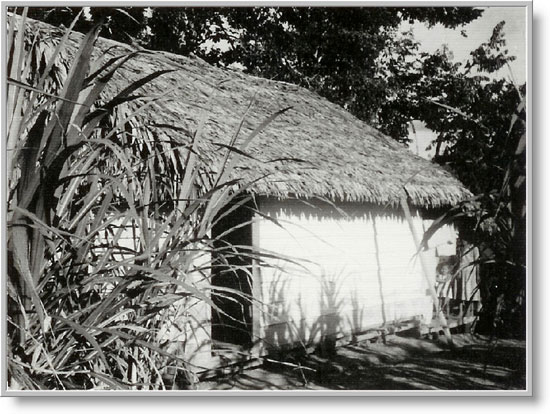
Below you see the Collins Tape Dipole. It is clearly marked for where it is resonant for a particular frequency. It was only necessary to play out the required length of tape an lock it in position. One end was about 45 feet high. We asked a Brazilian Indian boy to climb the bananna trees and we would give him a tip. He did a nice job of getting the dipole almost 50 feet in the air.
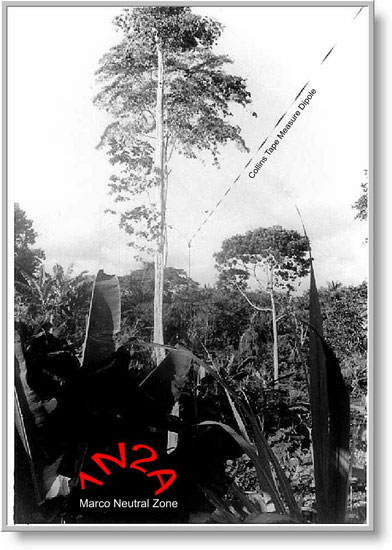
Carlos Fonseca (TI2CMF/TI2CF, HK3VA) and I traveled to this remote town on the Amazon river in May 1969. I had been there twice before alligator hunting in the Amazon tributaries near Leticia. This was a very remote area 40 years ago. Most of the travel to Leticia or Tabatinga was via the Amazon River from Manaus, Brazil, some 560 air miles southeast, or at least twice that distance on the Amazon River. The Air Force plane we flew down on was carrying two tons of garlic in large bags that we had to sit on. There were no seats on the plane and no seat belts or straps. The trip by plane took about 8 hours to get to Leticia from Bogota because it had to stop en route at a number of other Colombia military outposts along the Amazon river in the southeastern part of Colombia. During and after the flight, we both stunk like garlic for the next two or three days after our arrival. This might have actually afforded us a little bug protection but we never considered that at the time. All we could think of was the absolutely terrible smell. But the trip down from Bogota only cost us about $20 round trip as I recall. At each point, we stopped along in the State of Amazonas. The plane would take about 30 minutes to unload. The heat and humidity was absolutely unbearable, even for young men in their prime.
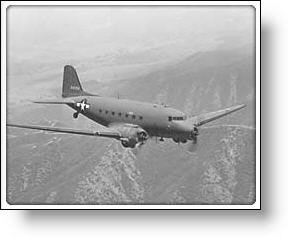
Carlos and I had talked about just setting up the operating station in the Hotel room in Leticia only about a mile from where we later established our operational site in Marco Neutral Zone. We really didn't want to do that because of all the fury over a pirate DXpedition to Malpelo Island during the early 1960's, perhaps 1962. At that time, Colombian hams operating from either Cali or Barranquilla and ran their entire DXpedition from their hotel room. All the Colombian hams knew about that pirate operation and it embarrassed them. It had shamed the LCRA or Liga Colobiana de Radio Aficionados. No, we wouldn't do that with the 1N2A DXpedition. Even though, by going into the Marco Neutral Zone, there would be a real danger of being bitten by a bushmaster snake (or "cascabel" in Spanish). That is the most deadly snake in South and Central America. You die within minutes of a snake bite and they exist in this region of the Amazonas. People in Leticia actually warned us of the possibility of being bitten by one of these dangerous snakes. There also were lots of other critters in the jungle to be afraid of. But we went ahead and took the risk of setting up in the jungle anyway.
So as noted earlier, during the 1930's there had been a war between Colombia and Brazil and they finally ended it by agreeing to redefine the border by conducting a new survey to settle the dispute. But the new survey was inaccurate like the earlier one and so after the survey was done the border area had this neutral zone between the two countries which was just fine for both sides. They didn't want another war. They just installed cement markers about 1/2 miles apart in the jungle. The actual strip of land seems to be about 0.7 of a mile in width. Marco simply means "Marker" in Spanish. Everything was fine for 30 some years until we came along in 1969 and put our radio equipment in that neutral zone.
Below you see one of the boundary markers that identifies this area as Marco. The CB walkie talkies were to be used in case one of us ventured too far away from the radio shack. It was easy to get lost very quickly. In the photo you see Carlos Fonseca in front of one of the markers that stood about four meters high. There were markers on either side of Marco Neutral Zone, or "No Man's Land" as they said in Spanish - "Tierra de Nadie." Carlos was then a Costa Rican diplomat and I was a U.S. diplomat. We both were bilingual in Spanish and English.
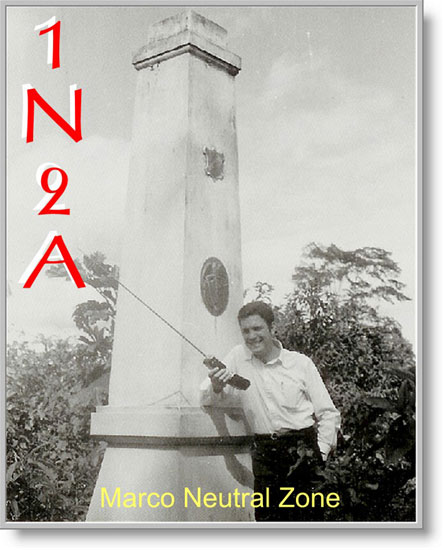
After one complete day of DXpedition operation, I got up in the morning of the 2nd day and went out to document our location by taking photos of the cement markers. I knew there were two cement markers on either side of that strip of land called Marco and I wanted the photos, which I actually got. I took along my 1-watt CB walkie talkie so I could stay in touch with Carlos who remained at the ops site in the jungle, working huge pile ups, which Carlos was very good at. I was really fearful of getting lost alone in the jungle. But I walked merrily along by myself in this really remote area getting pictures of everything I found interesting. Suddenly, along came a Brazilian military patrol running through the jungle with weapons in hand. They spotted me, quickly arrested me and confiscated my camera and walkie talkie. They began interrogating me on the spot in Portuguese. I don't speak Portuguese but I spoke very good Spanish, so we could communicate after a fashion. The armed soldiers guided me towards the Amazon River along very narrow jungle paths. Upon arriving at the Amazon River, they put me into a long motorized dugout canoe and took me down river to the Tabatiga military garrison located in Brazil. There they put me into a decrepit stockade and brought in an interrogator. From time to time, they would point the muzzles of their rifles into my face, trying to intimidate me, which it did. I'd had nothing to eat since the night before, so I was starving. At some point they brought me something awful to eat, like black beans and cornbread, which undoubtedly was their staple fare.
The Brazilians questioned me for hours in Portuguese and I would respond to their questions in Spanish. Finally, late in the afternoon, they brought in a Brazilian who'd lived in Guyana who spoke broken English. He was very mild mannered and even seemed a bit embarrassed by it all. He was just following instructions, I'm sure. He interrogated me some more, trying to get me to confess that I was on some kind of spying mission and was taking pictures of their Brazilian military positions. I stuck with my story, told him where I worked in Bogota and what I was doing in Leticia. They still didn't know where Carlos was or that he was operating a ham radio station in Marco Neutral Zone. By this time, I got the firm impression that the Brazilians had long forgotten about the neutrality of this strip of land called Marco. Throughout the interrogation, I came to understand that the Brazilians apparently believed this land called Marco belonged to them and was not shared with the Colombians. They pretend to know nothing about the disputed area. They simply claimed it all for themselves.
So as it was getting towards dark I began to mildly threaten the Brazilian commander through his interrogators to release me or I would raise a stink with the U.S. embassy upon my return. It just happened that I remembered the names of a couple of Brazilian top ranking military officers. I mentioned their names and told him that he must do the proper thing and release me or that I would get the word back to them of what had happened to me during my forced arrest and detention. I later learned that the garrison commander was a Lt. Colonel who was desperately waiting to be promoted to a full colonel. So I think he may have thought better of my situation and its potential blow back and decided to release me. I also think he finally was getting tired of it all and decided to let me go, otherwise he might suffer the consequences of a real political incident on his hands.
So at the end of the day, the Brazilian soldiers finally put me on the back of an off-road 50cc motorcycle and took me along a narrow jungle trail all the way back to Leticia. It seemed like it was taking hours to get through those jungle trails. For all I knew at the time, they were just going to kill me out there in the jungle and be done with me. They didn't say what they were actually going to do with me and it was getting dark, real dark in the jungle with a high canopy blocking most light. Then we came to a camouflaged military position in the jungle and several armed soldiers stepped out and made me dismount from the back of the motor cycle. They searched me for guns. Usually I carried my .357 magnum in Colombia because I had an MOD permit to carry it. However, once we went into the Marco Neutral Zone, I decided to leave it in my suitcase back at the little hotel in Leticia. So not finding any contraband on me, the Brazilian soldiers put me back onto the motorcycle to be taken to the Brazilian consul's residence in Leticia. When I finally got there, it was around 7:30 PM and dark. The Brazilian consul received me after shouting a few curse words at me for my wrong doing and waved goodbye to the Brazilian soldiers. This had all been for show he said. Then he hurriedly took me into his home to meet his family. He wanted to know what had really happened to me. I told him who I was and what had occurred with me in the neutral zone. I told him how I'd been interrogated at gun point by the Brazilian army soldiers. He shouted out to me in Spanish, "Those stupid animals" and he apologized profusely as he poured me a whiskey and soda. He didn't want to have any problems with me either as a result of the actions taken by the Brazilian army and their detention of me for almost 12 hours. Then, as means of an apology for all that had happened, he invited me into his home for a couple more whiskey soda drinks and some dinner with his family. The drinks and the food tasted very good indeed. Then his teen age daughter was introduced to me and I can still remember to this day how truly innocent and beautiful she was. I was immediately smitten by her beauty and Latin American charm. Then I remembered to my great dismay, that I still reeked of garlic from the flight down from Bogota. So here I was in some jungle outpost in the Amazon jungle basin having dinner with the Brazilian consul and his lovely family. We talked a bit more and I did my usual amount of flirting with his daughter, all the time trying not to remember the garlic smell. The entire experience in this home left me with a wonderful Alice in Wonderland feeling about the Brazilian consul's daughter and his fine hospitality. The image of her and this nice Brazilian family settled my otherwise frayed nerves. Finally the consul walked me back to the hotel over clay roads where Carlos (TI2CMF) and I were staying. It had been a very dangerous day for me but had ended well. In retrospect, I suppose the Brazilian army soldiers were just doing their job and didn't expect they would find the likes of me strolling into one of their jungle posts that May morning of 1969.
When Carlos saw me at the hotel in Leticia, he was mad at first because he though I'd abandoned him in the jungle ops area where we had the SSB/CW station set up. But then, when he made his way back into Leticia through the jungles, he learned from Mike Tsalikas that native Indians in the area had reported to him that they had actually seen the Brazilian army capture me. They also reported that the Brazilians had take me down the Amazon River towards Tabatinga. In fact, this was the talk of the little town of Leticia that day in early May, 1969. I would later find out that this news had been passed up and down the Amazon River among the various Indians who lived along the margins of the river. On an earlier trip, I had met many of them in their river little villages and acted as a doctor in curing some of their infectious diseases with antibiotics I'd brought with me. So some of them actually knew me.
Upon hearing of my fate in the hands of the Brazilian military, Mike knew right away that I was in very real danger because he'd lived in Leticia since the mid-1950's. He said to me later, he was sure the Brazilians would take me down river, kill me, and then just dispose of the body. It had happened many times before. So he went to the commandant of the Colombia marine battalion in Leticia to tell him what had happened to me, based on the information he had from the Indians that saw me when I was first captured. Together Mike and the Colombian marine commandant devised a plan to assemble his battalion and march through the jungle straight to the Brazilian army detachment and demand my immediate release. In fact the Colombian marine battalion was getting prepared for this event that evening when I returned. All of this had occurred late in the day, so the commandant decided that if I was not released by the following day, they would put on their combat gear and go calling at the Brazilian army base in Tabatinga. Of course I was released late in the day of Saturday, May 3, 1969. Mike kept telling me over and over again after he saw me, just how damned lucky I actually was that they had not killed me and dumped my body in the jungle where the flesh would have been consumed within hours by insects and jungle rats. It really put the fear of God into me. So that night, Carlos, Mike, and I had a several whiskey sodas together and talked even more about how bad it could have actually been for me.
The 1N2A expedition really was cut short because of this unfortunate incident. If I had not gone out to photograph the Marco cement markers, it might never have occurred in the first place. The whole idea for the expedition came from Enos Schera (W4VPD) who had been with us on the February 1969 Malpelo Island DXpedition, and who later became quite a DXpeditioner himself. The next year after the 1969 Malpelo Dxpedition, he went on to Navassa and other places in the Caribbean. Enos came up with the Marco callsign of 1N2A. Afterwards, everyone seemed to refer to it as the "Transistor Expedition". Apparently in those days, there was a popular diode with that same nomenclature. But Enos recognized early on, that if we could actually verify that this place was a true neutral zone, then it would, in fact, qualify as a new country, once the ARRL recognized it. It would be just the same as the neutral zone that existed between Iraq and Kuwait.
Before the DXpediton phase of the trip to Marco, and just after my arrival in Leticia, I set about to get documentation proving Marco was a neutral zone. On previous trips to Leticia, I'd spoken at length with Mike Tsalikas about the status of Marco. However, on May 2nd, I got Mike to give me a paper saying it was a Neutral Zone. The document had his U.S. consular stamp at the bottom. However, after this incident which almost caused another war between Brazil and Colombia, I though it better to forget about the documentation needed for the ARRL and just get the hell out of Dodge City. I don't remember how many contacts Carlos and I made. I remember that Carlos did most of the operating. He was, and still is, I'm sure, an excellent DX and contest operator. I can remember we had a very good path to the U.S., Europe, and the Middle East.
After that DXpedition, Carlos and I were just eaten up with bug bites from the souls of our feet, up to our hips. The itching and pain came about two days after our expedition. Our legs were aflame with severe itching. What happened was that as we walked through the jungle, there was a lot of jungle grass or some kind of very small mites that bit into our legs through our pants and caused the most painful itching sensation we'd ever had in our lives. It absolutely drove me delirious until I discovered that by taking antihistamine, it reduced the swelling, redness, and itching sensation. But Carlos really went berserk with it. One night after we arrived back in Bogota, perhaps a day or two after we returned, his wife called me at two in the morning and said that Carlos couldn't stand the pain any longer. I told her to give him antihistamine, which apparently she did. That was a pretty horrible experience for both of us.
So there was quite a lot of adventure associated with the 1N2A expedition to Marco Neutral Zone located in the deepest part of the Amazon River basin, where Peru, Brazil, and Colombia come together. Each of my trips to the Amazon River were dangerous to some extent. Once I got stuck in quicksand trying to extricate another companion. And there was the scare of being struck by a bat at 3:00 AM while on an alligator hunting trip along a tributary of the Amazon River, a couple of hours away from Leticia in a motorized pirogue or dug out canoe. There were always serious dangers in that era and undoubted still are today. Carlos and I always regretted not being able to document the 1N2A DXpedition, but no one wanted to precipitate another war between Colombia and Brazil over a silly DXpedition to a place known only as "No Man's Land" or "Marco" as it was then known to the natives.
Below you see a view of the great Amazon River that passes in front of Leticia, Colombia, and Tabatinga, Brazil. This is the border area for the 1N2A Marco Neutral Zone operation 40 years ago in May 1969. These are squatters' shacks on the water.
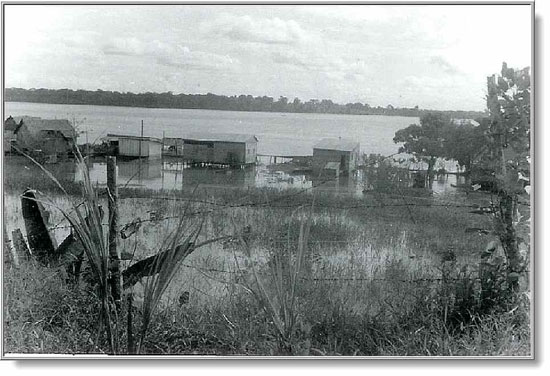
In the center of the next photo is the only photo of me. Here we see a man desperately stuck in quicksand. He had sunk down to just above his knees when I came to his aid and tried to pull him out. You may notice the gunslinger belt with .357 magnum rounds. Since the Bogatazo uprising of 1948, diplomats posted to Colombia have been authorized by the Colombian government to wear concealed weapons. Carry permits were issued to those who requested them. Colombia was very much a dangerous country to live in, especially the Amazonas district.
Eventually, after perhaps 15 minutes of work, we were able to extract this man from his predicament. I too had sunk down to the tops of my engineering boots and had to be rescued. In the background, you see the Amazon River. It widens considerably further south in Brazil. This is a location somewhere near Marco Neutral Zone, on the Colombian side of the border. Just about anywhere near the river there can be quicksand. One only walks along well established trails near the river margins.
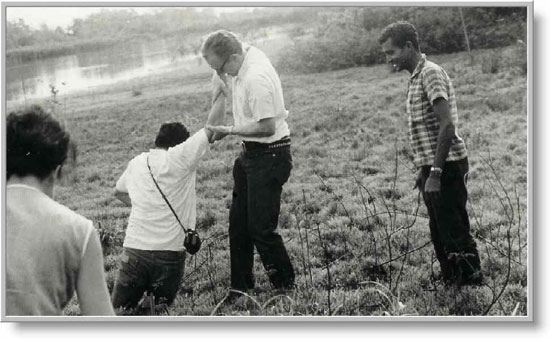
73, Don W4PUL
Carlos TI2CF was at the 1997 Dayton Hamvention!
QSL courtesy of K9MM
Photos and Story courtesy of W4PUL